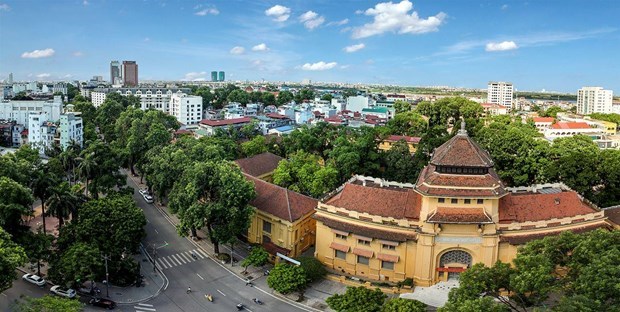 |
|
Architect Đoàn Thanh Hà. — Photos courtesy of H&P Architects
|
The award, in the framework of the International Contextual Architecture Awards in memory of Architect Turgut Cansever, sought proposals that exhibit original interpretations of Turkish Architect Turgut Cansever’s design principles.
These principles included adapting design to regional characteristics, promoting cultural continuity, regional values and distinctive local attributes. The award aims to highlight the importance of local identity in a globalised world, according to the award website.
 |
|
Hà's design of the Friendly Space in Suffocating Urban Areas in Thổ Hà Village.
|
Together with Hà, who founded the H&P Architects company, Indian architect Romi Khosla won the Turgut Cansever Grand Prix.
Şakir Köse was awarded the Turgut Cansever Local Award with Yeniçeri Ahmet Ağa Konağı (İbradı). Jury Mentions went to Kanishka Padmapani "Cafe Ufo" from Sri Lanka and Uğur Yıldırım "Lucien Aras Art Gallery and Library" from Urla, according to the website.
The international jury was composed of various experts from the global architect community, like Ian Ritchie (UK), Antonio Riverso (Italy), Suha Ozkan (Turkey), C. Abdi Güzer (Turkey) and UIA Representative Martin Drahovsky (Slovakia).
Turgut Cansever (1921-2009) was a Turkish architect and city planner, who is the only architect to win the Aga Khan Award for Architecture three times.
Dubbed "The Wise Architect", he took charge in many towns, zoning and protection area projects.
He designed Beyazit Square and was the author of the first art history doctoral thesis in Turkey.
Hà’s Friendly Space in Suffocating Urban Areas began construction in 2013 in Thổ Hà Ceramic Village in the northern outskirts of Hà Nội.
The jury highly appreciated his capability to “combine architect’s desire with traditional architecture features to serve the local community".
Hà said he got the inspiration for the project when he visited the village in 2008. He proposed local authorities to build an open space for the ancient village with high density of construction. He also proposed to revive ancient ceramic handicraft and ancient scenery of lanes in the area to ensure sustainable living.
The project won first prize at the FuturArc 2009, which is among the first architectural prizes for green design in Asia.
“Urban space in Việt Nam is getting more and more suffocating in terms of both construction density, material and the way to create space, which is a lack of connection between the inside and outside area,” he said. “In order to reduce suffocation, first and foremost, the design should be environmentally-friendly."
To reach that purpose, Hà introduced non-border tools (no gates, no fences), no distinguish (between in and outside, between the architecture and surrounding landscape), no limitation (no border to users). He mobilised available materials in the locality like bamboo, clay and stone.
 |
|
A private house designed by Hà's company.
|
In the project, beside community buildings, Hà designed three private houses. The houses have been all completed on a total area of less than 40sq.m each, which meets three criteria: having at least three storeys; consisting of three parts of frame, cover layers, staircases and furniture; with utilisable roof for gardening or installing solar-power system.
Hà is widely known for various environmentally-friendly projects like The BE friendly made in 2016 in Quảng Ninh Province and The S Space built in 2018 in Hà Nam Province.
 |
|
The BE friendly made in 2016 in Quảng Ninh Province.
|
He has just finished the project Reviving Mạo Khê Coal Mine in Quảng Ninh Province and is creating a village from clay and bamboo in Lạng Sơn Province, which will be completed at the end of this year. — VNS

World Architecture Community Awards honours Sky House
Sky House by architect Nguyen Hoang Manh won a Realised Award at the 33rd World Architecture Community Awards in London.

Hanoi charming with unique architecture
Hanoi, a charming city with a history of over one thousand years, is the convergence of cultural and historical essences of Vietnam.
 Architect Doan Thanh Ha, based in Hanoi, has just received the Turgut Cansever International Award 2020 for his project titled Friendly Space in Suffocating Urban Areas.
Architect Doan Thanh Ha, based in Hanoi, has just received the Turgut Cansever International Award 2020 for his project titled Friendly Space in Suffocating Urban Areas.